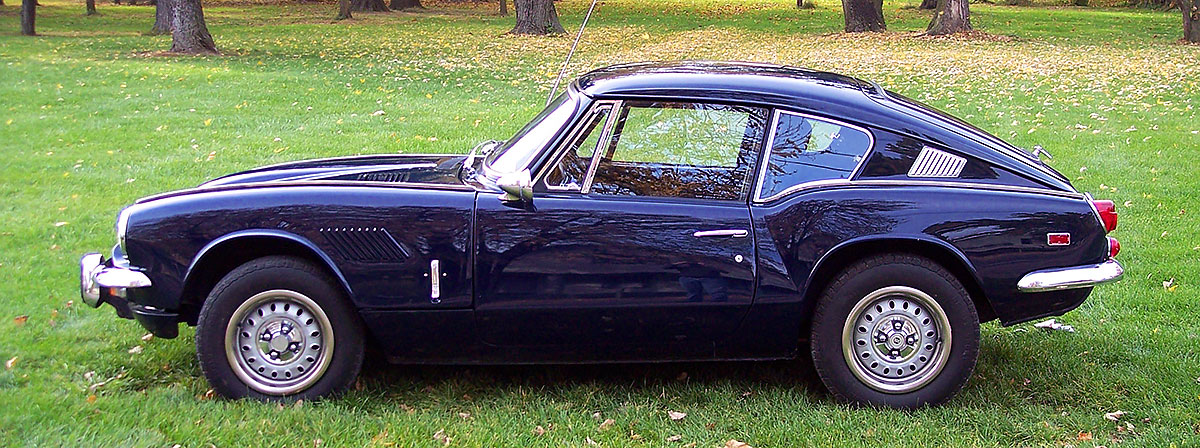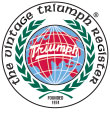
Triumph Buyer’s Guides
Basic Considerations When Contemplating a Triumph
by Arthur Kelly
If you are looking for a Triumph, here are some basic ideas:
- Body work is more expensive than mechanical work. So you want as rust free a car as possible. If the car has already been restored check for bondo and painted over rust with a magnet. Also get it up on a lift and check for frame rust. The more rust you find the less it is worth, the more work you will have to do, and possibly you might not want to buy it. Places to look are wherever two pieces of metal come together or wherever water can accumulate. Use a flashlight and a screwdriver to scrape away undercoating etc.
- Mechanically, the car should be sound or you must know what needs to be done. Check engine for compression, smoke and general condition. If the car is driveable, take it for a ride. Check for clutch operation, shifting, and ride handling.
- Do some research! Here’s how:
- join a local TR club. Nice people and much expertise. A list of VTR Chapters is online .
- go to the library or a bookstore and get some books on Triumphs. Bill Piggott’s book “Original Triumph TR” is a good one for general TR2-TR6 info and history but there are others.
- Get on the “triumph list”. For details of the list and how to get on it, see the Triumph Mailing List page.
- How much you should pay for the car depends on the condition. Go to a bookstore – Barnes and Noble has magazines which give prices and conditions for cars. There is one magazine which gives the car, year, model and 1 thru 6 numbers to describe the condition. It then gives a price for each number.
- Remember the old addage “Marry in haste – repent at leisure” You are about to do something similar to a marriage. First decide what you want to use the car for i.e. daily driver, occasional use, restore to”concours” – whatever. Then decide how much you want to work on it to get it to that use. Of course you must consider your mechanical abilities and/or how much you want to pay someone else to do the work. The cars are out there, look on finding the one for you as a quest and be patient.
That’s a start. Remember it’s your money and time. Generally, unless you’re really more interested in restoration than driving, you would be best served by not buying a car which is “in parts”. Most people want a Triumph that can be driven and enjoyed whilebeing fixed up. Now to find the car that is right for you check the VTR classifieds and publications such as Hemming’s Motor News for Triumphs for sale.
Model-Specific Buyer’s Guides
More detailed information is provided for each of the specific models:
- GT6
- Italia
- Herald/Vitesse
- Southern Cross
- Spitfire
- Stag
- TR2
- TR3/3A/3B
- TR4
- TR4A
- TR5/TR250
- TR6
- TR7
- TR8
- 2000 Roadster
Checklists and Bill of Sale Paperwork
by Lawrence Buja and Roger Garnett
In order to help you with a purchase, some forms and checklists developed by readers of the british-cars mailing list are also available online:
All forms are in Adobe Acrobat format and will open in new windows.
- Bill of Sale — official-looking bill of sale, particularly useful for old cars with no title
- Checklist — Phone Screen — a handy form for phone screening cars for sale
- Checklist — Examination — the checklist to use when looking at a car for sale
- Checklist — Road Test — what to look for on the test drive
- Odometer Statement — odometer statement disclosure form
- Package of Buyer’s Forms — 5-page package of each of the above forms.
Some Simple Mechanical Checks
Here are a few generic tests. Some you can do yourself and the rest a mechanic should be able to do at a reasonable cost in about 30 to 45 minutes.
- Run a compression test. Indicades ring and valve seal.
- Have the oil pressure tested by a seperate guage. Indicates engine and oil pump wear.
- Have the water in the radiator tested for exhaust gasses. Indicates head gasket leaks.
- Drive the car and see if the transmission shifts smoothly with no grinding or knocks. Listen and feel for bad synchros and chipped teeth.
- Let off and on the clutch slowly, feeling for a full positive engagement with no slipping. Indicates a bad clutch.
- Try braking hard in an open parking lot. Indicates brake problems.
- Check the oil for clouding and look for grey slime on the dip stick. Indicates a head gasket leak.
- When checking for rust, take a small magnet to feel for thick areas of bondo.
- Welding may indicate serious rust problems or a major impact.
Where to get insurance
by Ken Streeter
If you’ll be driving you Triumph for regular transportation, you’ll need to get a policy from your regular insurer. However, if you are going to be using your Triumph primarily for club events or shows, you will probably qualify for classic car insurance. Such insurance is available at excellent rates to VTR members (members will find more details in issues of the VTR Magazine, The Vintage Triumph), as well as to the general public through many insurers such as those listed in Hemmings Motor News.
